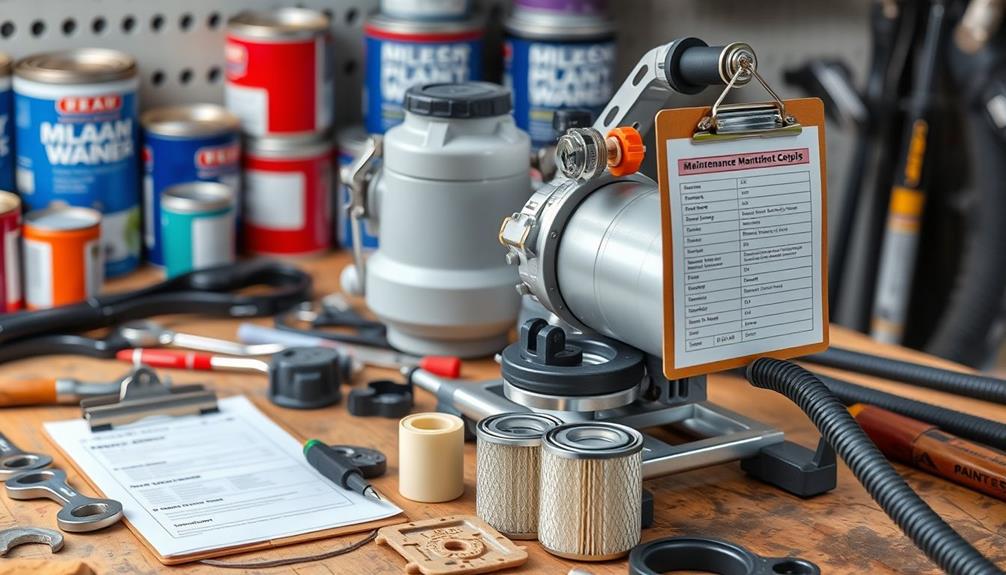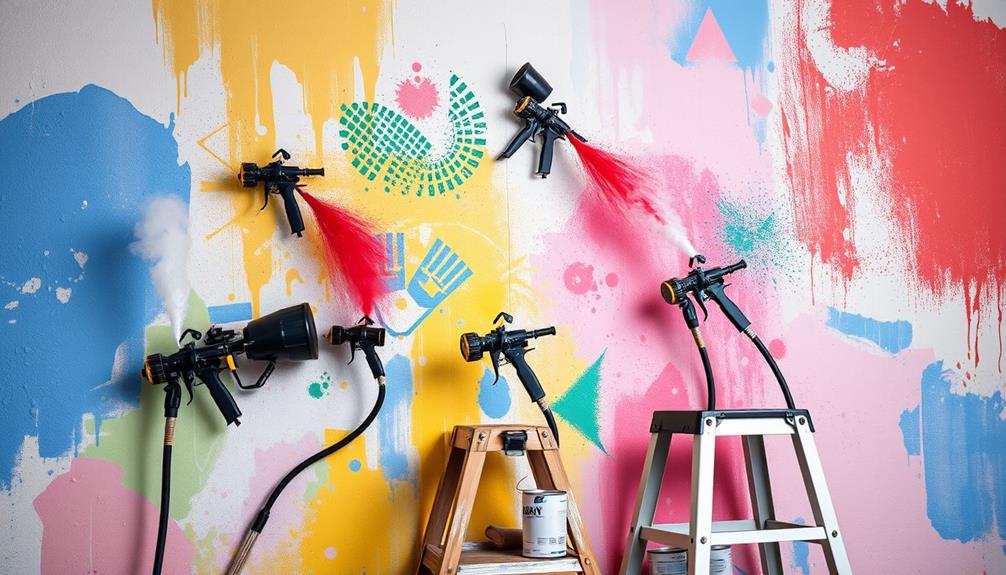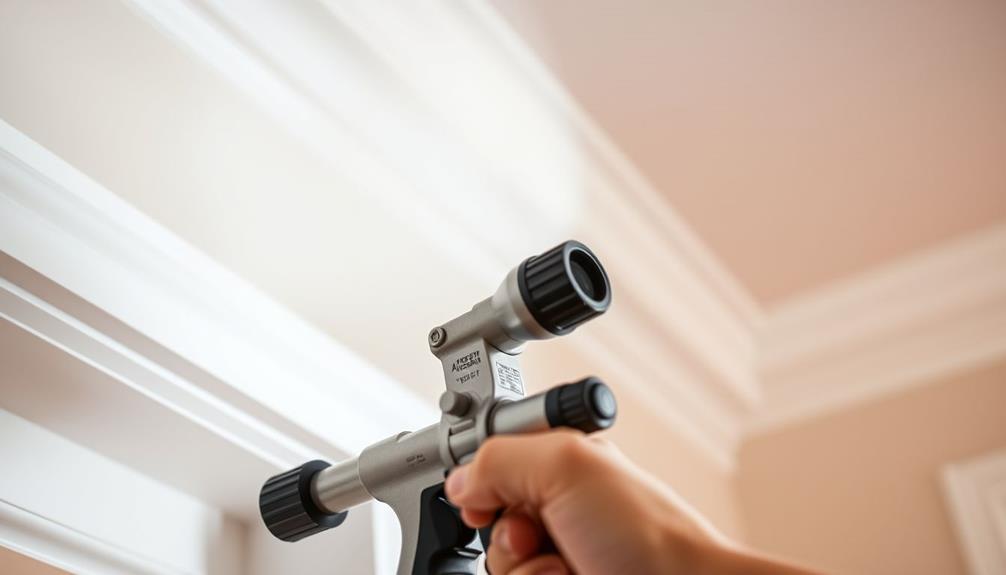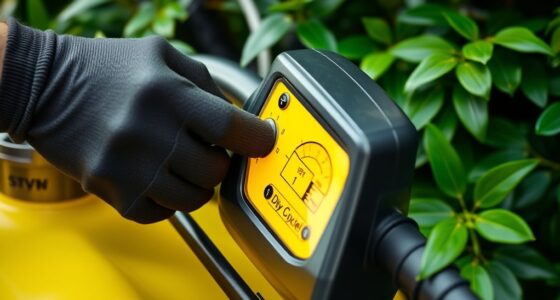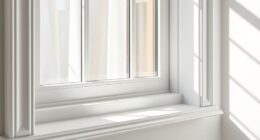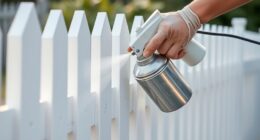To keep your airless paint sprayer in top condition, follow a strict maintenance checklist. Clean it thoroughly after each use to prevent paint buildup, and always flush the system with clean water. Check the gun filter weekly, and inspect hoses for wear or damage. Don't forget to winterize by using pump preserver and storing it properly. Monthly, replace worn spray tips to maintain finish quality. Finally, conduct annual checks at a repair center for thorough inspections. Stick to this routine, and you'll enhance performance and longevity, while discovering helpful tips for ongoing care along the way.
Key Takeaways
- Clean the sprayer thoroughly after each use to prevent paint buildup and ensure optimal performance.
- Regularly inspect and replace worn spray tips and filters to maintain consistent paint application.
- Follow proper pressure relief techniques before performing maintenance to ensure safety.
- Perform weekly and monthly inspections to catch potential issues early and extend equipment lifespan.
- Use pump saver and appropriate antifreeze solutions during winterization to protect internal components.
Importance of Maintenance
When it comes to maintaining your airless paint sprayer, regular upkeep is essential for maximizing its lifespan and ensuring dependable performance. One of the most vital aspects of maintenance is cleaning your airless after each use. This practice greatly reduces the risk of damage from dried paint and debris buildup, which can lead to costly repairs.
Additionally, understanding airless paint sprayer basics can further enhance your maintenance practices, as it allows you to recognize the importance of proper cleaning techniques and the right cleaning solutions.
Make sure to pay special attention to the gun filter during your cleaning routine. A clogged filter can impede the sprayer's performance, resulting in uneven paint application and frustration on the job. By regularly checking and replacing the gun filter as needed, you'll maintain ideal functioning.
Following a structured maintenance schedule—daily, weekly, and annually—helps you identify potential issues early on. This proactive approach prevents unexpected downtime, ensuring your projects run smoothly.
Products like Graco Throat Seal Liquid (TSL) can also be beneficial; they keep packings wet and reduce wear, thereby enhancing overall efficiency.
Neglecting maintenance not only ramps up repair costs but can also create considerable operational issues. By committing to regular upkeep, you'll enhance your sprayer's reliability and productivity, ultimately making your painting projects more efficient.
Regular Maintenance Steps

To keep your airless paint sprayer running smoothly, start with a thorough cleaning immediately after each use. This prevents paint buildup and protects the internal components from damage.
Begin by flushing the system with water or solvent, depending on the paint used. Don't forget to clean the spray gun and remove the airless spray tip for a detailed wash. Using the Graco FFLP Fine Finish Low Pressure Reversible Tip can enhance your control and finish quality during intricate projects.
Next, use Graco Throat Seal Liquid (TSL) to keep the packings wet, which helps reduce wear during operation.
Daily inspections are essential, so check the manifold filter, gun filter, and inlet strainer to guarantee proper flow and avoid clogs. If you notice any debris, clean or replace the filters as needed.
Also, check the wet cup for leaks and tighten it if necessary to maintain pressure and prevent paint loss.
Finally, regularly replace worn airless spray tips. This not only improves your finish quality but also reduces paint usage and minimizes strain on your equipment.
Weekly and Annual Checks

To keep your airless paint sprayer in top shape, you should perform weekly inspections and schedule annual maintenance.
Regularly checking components like the wet cup and filters helps you catch issues early, preventing breakdowns when you need your sprayer most.
Additionally, consider using a home cleaning service to maintain a clean workspace, which can positively impact the longevity of your equipment.
Don't forget to visit an authorized Graco Repair Center for those annual check-ups to guarantee everything runs smoothly.
Weekly Inspection Tasks
Performing weekly inspections on your airless paint sprayer is essential for maintaining its efficiency and longevity. By dedicating some time each week to check various components, you can prevent issues that may lead to costly repairs or downtime.
Start by tightening the wet cup to avoid paint leaks, and inspect high-pressure paint hoses for any signs of wear or damage. Additionally, confirming your workspace has good air quality can enhance your overall painting experience, as air purifiers reduce allergens that may affect your health.
Make sure to check the following items during your inspection:
- Inspect the manifold filter, gun filter, and inlet strainer for clogs or debris.
- Verify that all fluid connections are secure and free from leaks.
- Regularly check the condition of the sprayer's packing nut and adjust as necessary.
Document any findings during your inspections. Keeping track of maintenance history will help you identify recurring issues that may need further attention.
By staying proactive with your weekly inspections, you confirm that your airless sprayers operate smoothly, minimizing the risk of pressure loss and inefficiency.
Annual Maintenance Scheduling
Scheduling annual maintenance for your airless paint sprayer is vital to keeping it in peak condition. Make it a priority to book a check at an authorized Graco Repair Center. This guarantees your sprayer remains in ideal working order and allows for any potential issues to be addressed before they escalate.
Regular maintenance is similar to the importance of home security systems in protecting your valuable equipment and providing peace of mind. In addition to your annual maintenance, conduct weekly inspections to tighten the wet cup and check the high-pressure paint hoses for signs of wear or leaks. These small, proactive measures can help you avoid costly repairs down the line.
Regularly inspecting the manifold filter, gun filter, and inlet strainer daily will maintain your sprayer's performance and prevent blockages that could disrupt your work.
It's also important to keep a record of all maintenance activities—this includes inspections and repairs. Tracking the condition of your airless paint sprayer will help facilitate timely servicing and allow you to identify any signs of wear and tear during your weekly checks.
Early Issue Identification
Regular inspections play an important role in early issue identification for your airless paint sprayer. By conducting weekly checks, you can spot potential problems before they escalate into costly repairs.
Make it a routine to inspect the manifold filter, gun filter, and inlet strainer to verify they're free from debris and functioning properly. This helps prevent clogs and keeps your sprayer efficient. Additionally, making sure you have a reliable power source for your sprayer is vital, as gas appliances typically function without electricity and can offer peace of mind during power outages.
Here's a quick checklist for your weekly inspections:
- Tighten the wet cup to prevent leakage; a loose cup can lead to paint loss and higher costs.
- Regularly inspect high-pressure paint hoses for signs of wear or damage to avoid leaks that could compromise safety.
- Don't forget to check the tip guard for any blockages or cracks, verifying a smooth spray pattern.
Additionally, schedule an annual maintenance check at an authorized Graco Repair Center. This thorough inspection can identify issues you might miss, helping you maintain performance.
Document all maintenance activities, including inspections and repairs. Doing so will give you insights into your sprayer's condition and help you spot recurring problems, making sure your equipment remains in top shape.
Winterizing Procedures
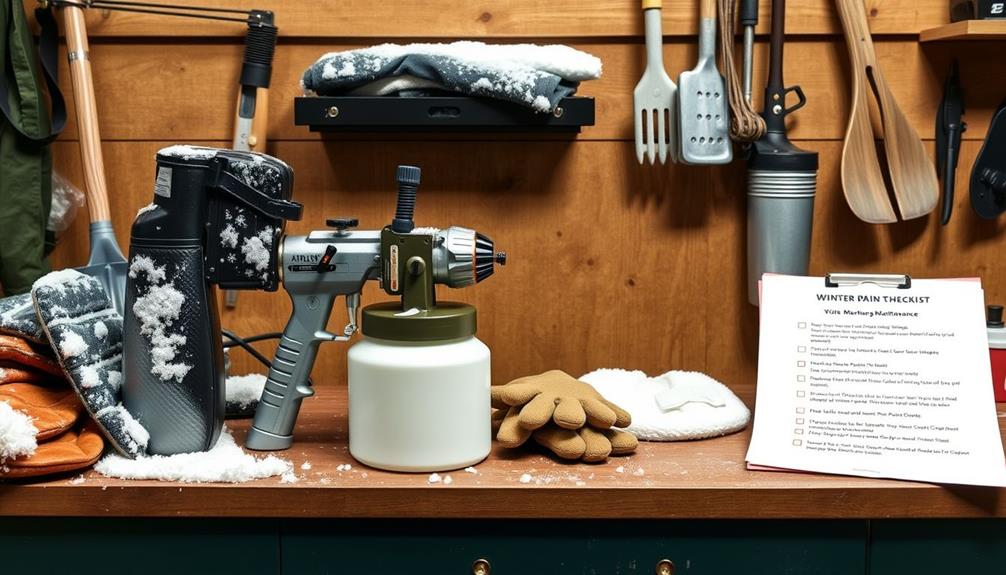
To guarantee your airless paint sprayer remains in top condition through the winter months, it's vital to follow proper winterizing procedures.
Start by thoroughly cleaning your sprayer to prevent dried paint from causing damage, as neglecting this can lead to extensive repairs. If you skip this step, you could face costly repairs in the spring.
After cleaning, consider using a pump preserver like Graco Pump Armor to protect the internal components during storage. Many other tools and products, such as safety glasses, can also enhance your maintenance routine.
When winterizing, avoid using automotive anti-freeze as a preservative. It can harm your sprayer's internal parts. Instead, run clean water through the pump to remove any residual materials. This step is vital for preparing the sprayer for winter storage, ensuring that nothing hinders its performance.
If you notice any dried paint on the pump rod, it's best to seek professional cleaning services. Neglecting this can lead to serious internal damage and extended downtime come spring.
Spring Cleaning and De-winterizing

As spring arrives, it's important to give your airless paint sprayer a thorough cleaning and de-winterizing to guarantee it's ready for your projects. Start by flushing the pump with clean water to remove any residual fluids.
If you cleaned your sprayer properly before winterizing, you'll find that minimal effort is required—often just a simple flush and inspection will suffice. In addition, consider utilizing eco-friendly materials during your painting projects to contribute to sustainability.
However, be vigilant for any dried paint on the pump rod, as this may necessitate professional cleaning to prevent significant internal damage.
Be sure to inspect all hoses, filters, and connections for signs of wear or damage that might've developed during storage. Running clean water through the entire system is vital for preventing clogs and guaranteeing smooth operation when you're ready to start using the sprayer.
- Check for any leaks in hoses and connections.
- Inspect filters and replace them if clogged or damaged.
- Confirm the pump rod is clean and free of paint buildup.
Daily Maintenance Tasks

When you finish using your airless paint sprayer, it's essential to clean it thoroughly to keep it running smoothly.
Regular maintenance practices, such as confirming proper flushing issues are addressed, can help prevent long-term damage to your equipment.
Make certain you follow proper pressure relief techniques to guarantee your safety during maintenance.
Staying on top of these daily tasks will help extend the life of your sprayer and maintain its performance.
Daily Cleaning Procedures
After each use, proper cleaning of your airless paint sprayer is imperative to maintain its functionality and longevity. Start by thoroughly cleaning the sprayer immediately after use. This includes all filters, suction hoses, and the gun to prevent paint buildup and potential damage.
Regular maintenance is essential for keeping your equipment in good working order, just as regular vet check-ups are critical for your dog's health.
Here are some key steps to follow:
- Remove the flexible suction hose and flush it with clean water to guarantee no paint residue remains inside the system.
- Test the sprayer with water to check for consistent pressure, ideally maintaining a range of 3300 psi for peak performance.
- Use a pump saver during the final flush to protect internal components from rust and scale buildup during storage.
Additionally, applying a piston throat seal before transporting the sprayer will help avoid leaks and maintain the integrity of the system.
Always prioritize these cleaning procedures to keep your airless paint sprayer in prime condition, making sure it works efficiently for your next project.
Regular maintenance won't only enhance performance but also extend the life of your equipment.
Pressure Relief Techniques
Pressure relief is an essential step in maintaining safety and efficiency with your airless paint sprayer. To begin, always engage the gun trigger lock and close the bleed-type master air valve before attempting any pressure relief. This prevents accidental spraying while you're working on your sprayer.
Next, hold the gun against a grounded metal pail and trigger it until all pressure is released. This step is important for your safety.
Afterward, drain any remaining fluid by opening all fluid drain valves into a waste pail. This prevents fluid buildup in the system, which can lead to clogs and other issues.
If you suspect clogging, carefully loosen the tip guard or hose end coupling to safely clear any obstructions. Make sure you do this slowly to avoid injury.
Lastly, always follow the pressure relief procedure before any maintenance tasks. This guarantees safe operation and helps prevent accidents.
Monthly and Yearly Maintenance
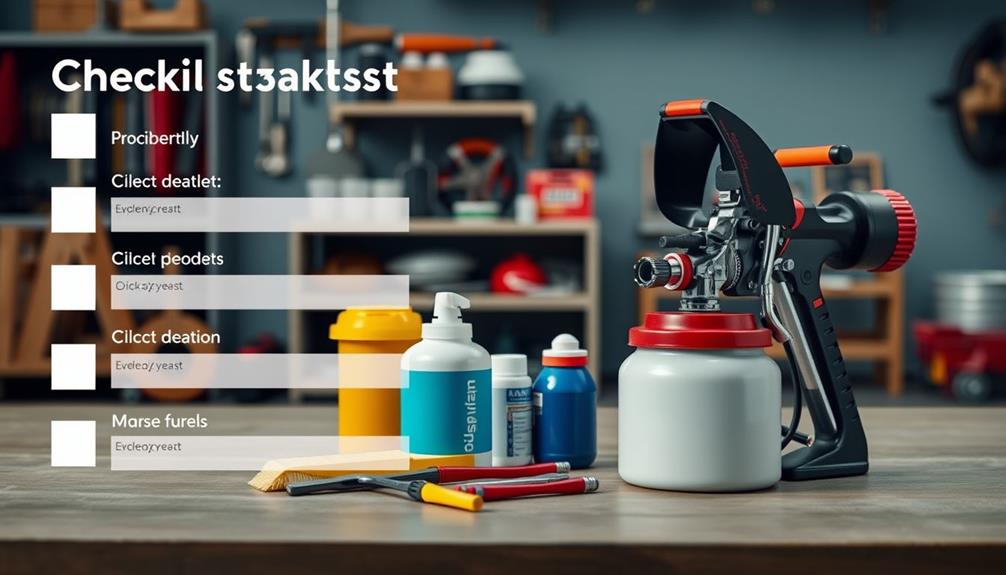
Regular monthly and yearly maintenance is vital for keeping your airless paint sprayer in top condition. If you use your sprayer heavily, perform monthly maintenance to inspect the foot valve and seals for debris and damage.
Even if you're an occasional user, consider checking every six months based on your usage frequency. During your monthly inspection, make certain to clean the threads and apply marine grease to facilitate easier disassembly and reassembly of components.
For yearly maintenance, you'll want to conduct a thorough inspection of the paint hose. Look for abrasions and any signs of damage; replace any compromised hoses immediately to guarantee safe operation.
Changing packing seals annually is also important. This step helps prevent premature wear on your sprayer components, extending the overall lifespan and reliability of your equipment.
Here's a quick checklist for your maintenance routine:
- Inspect foot valve and seals for damage.
- Clean threads and apply marine grease.
- Check paint hose for abrasions and replace if necessary.
Safety Precautions
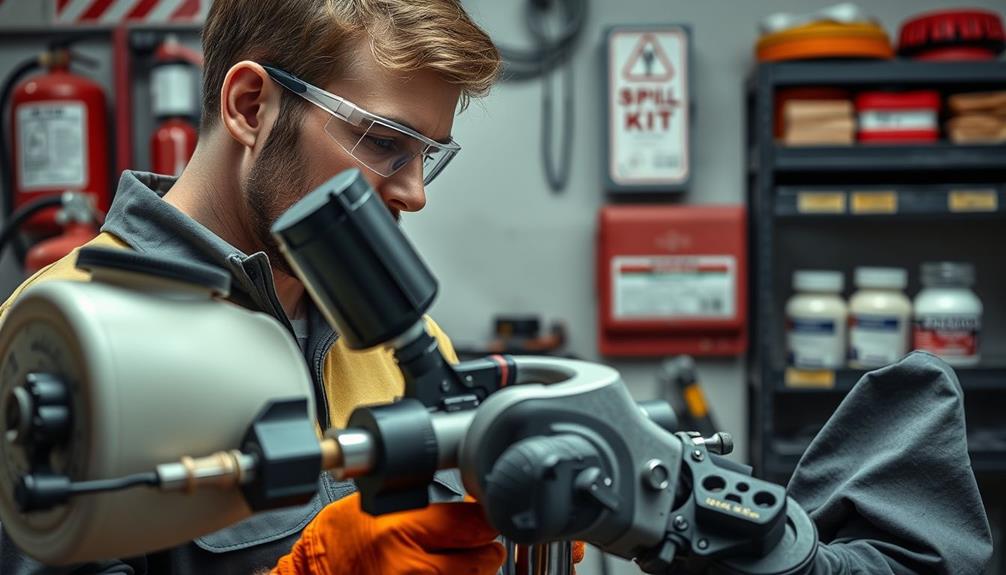
When using your airless paint sprayer, safety should always be your top priority. Start by aiming the sprayer's trigger away from people, and only release it when you're actively spraying. This simple action can prevent serious accidents.
Regularly inspect the hoses for any signs of damage or wear, as even minor flaws can lead to dangerous high-pressure leaks. Handle your sprayer with care; high pressure can be hazardous. Avoid unnecessary increases in pressure, which can escalate risks.
Before getting started, verify all attachments and connections are secure to minimize the risk of paint leaks and potential injuries. Always follow established safety precautions.
Wear appropriate protective gear, like goggles and masks, to safeguard yourself against overspray and inhalation of paint fumes. Staying protected is essential for a safe working environment.
Frequently Asked Questions
How Do You Maintain an Airless Sprayer?
To maintain an airless sprayer, clean it immediately after use, inspect filters daily, use Graco TSL to keep packings moist, schedule annual checks, and winterize with a preservative to prevent internal damage.
How Do You Maintain an Airless Sprayer?
You've got a paint-slinging beast in your hands, so treat it like royalty! Clean it right after use, swap out tips when they're worn, and don't forget to pamper those seals with TSL for longevity!
How Often Do You Need to Repack a Paint Sprayer?
You should repack your paint sprayer annually for peak performance. If you use it frequently, consider repacking every three to six months. Watch for leaks or pressure loss; these are signs it's time to repack.
Can You Leave Paint in an Airless Sprayer Between Coats?
You shouldn't leave paint in an airless sprayer between coats. It can lead to clogs and dried paint. If you must, fill the wet cup with a compatible solvent to keep everything lubricated.
Conclusion
By keeping up with your airless paint sprayer maintenance, you can extend its lifespan and guarantee peak performance. Did you know that regular maintenance can boost your sprayer's efficiency by up to 30%? That means you'll save time and paint while achieving a smoother finish. So, stick to your checklist, follow seasonal procedures, and don't overlook daily tasks. Taking care of your equipment not only enhances your projects but also makes painting more enjoyable and efficient.
